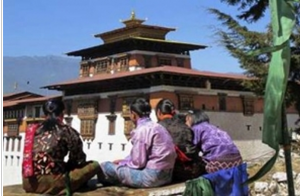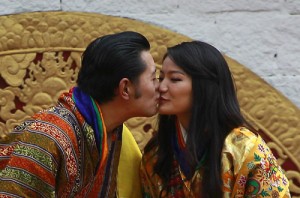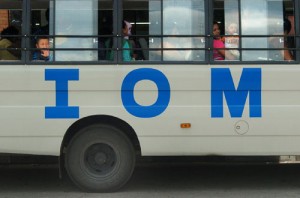Bhutanese without Bhutan
By Bhagirath Khatiwada

People in Bhutan live a submissive and dictated life under the autocratic rule of the regime… Hundreds of political prisoners are still facing inhumane torture in Bhutan jails simply because they raised their voice for human rights and democracy in the country
Bhutan is a landlocked principality in the Himalayas, which lies between the two big Asian giants, India and China. The Himalayan kingdom is also known to the world as one of the luxurious tourist destinations in the world. Because of its rich culture, innate hospitality, art and architecture, pristine nature with majestic mountains, Bhutan attracts tourists from different parts of the world.
It was the fourth monarch of Bhutan, Jigme Singey Wangchuck, who introduced the notion of National Happiness (GNH) in the early 1990s with an aim of establishing good governance, promoting sustainable development, conserving natural environment and promoting cultural values that floated exotic curiosity above and beyond. He not only abdicated his throne in favour of his eldest son, Jigme Khesar Namgyel Wangchuck in 2006, but also endowed democracy to his countrymen which eventually drew the feeling of great global liking towards Bhutan.
For others, this tiny kingdom also resembles the last Shangri-La —any place of complete bliss, delight and peace. However, against all these pluses and burgeoning scenarios, this Dragon kingdom has also gained notoriety for generating largest number of refugees in the world in proportion to its total area and population.

When we talk about Bhutan, it is worthwhile to mention Shabdrung Ngawang Namgyal, a Tibetan Buddhist monk who unified Bhutan as a nation state for the first time in 1616 AD. After unification, he felt acute need of varied professionals in the country for the nation-building purpose. Hence, to meet the rising needs in different fields, he visited the then Gorkha King, Ram Shah (one of the provincial kings before Nepal was unified) and invited Nepali speaking people to Bhutan with a promise of granting them equal rights and privileges as other Bhutanese in the country in 1624 AD. Thus, the Nepali-speaking Bhutanese along with other ethnic communities built the requisite infrastructure for the country.
With the passage of time , the Lhotsampas—people living in the south— rose and began playing major and influential lead in the areas of culture, economy, education, bureaucracy, protecting sovereignty and so forth, and actively contributed to the economic growth and all-round development of Bhutan.
However, the Wangchuck dynasty after having ascended to power in 1907 AD, started misunderstanding and misapprehending the progress made by the Lhotsampas, and above all, took the developmental works for a threat to political power of the ruling Ngalungs.
Sadly, the seed of mistrust was planted followed by a series of various discriminatory denationalising policies one after another targeting Lhotsampas and other minority groups. Thereafter, the ‘One Nation One People’ policy of 1989 demanded every citizen to speak only Dzongkha language, wear only Gho for male and Kira for female, and follow only the Drukpa Kargyupa sect of Mahayana Buddhism as the religion across the country. Correspondingly, the Druk regime brought the so-called Green Belt Policy in 1984 in the south with the hidden objective of displacing Lhotsampas.
Similarly, the Bhutan Citizenship Act, 1985 demanded Lhotsampas to furnish land tax receipt of 1958 from Ministry of Home Affairs to be qualified as a citizen of Bhutan no matter whether one possessed the citizenship card already or not. Interestingly, the ministry was established only in 1968 so one can easily guess whether the baby ministry could provide receipts of 1958 to the people or not. As a result of this massive highhandedness on the part of the reigning government, thousands of southern Bhutanese (of Nepali origin) were brazenly declared non-nationals, including those who had lived in Bhutan for generations and owned properties, simply because they could not produce the land tax receipts of 1958.
Similarly, the Marriage Act-1977 left more than 60,000 children stateless in the so called Last Shangri-La in the year 1988. Further, Lhotsampas and other minorities were discriminated and denied equal opportunities in education, employment and business.
Meanwhile, people could not tolerate the prevailing atrocities of the regime and appealed the then King Jigme Singey Wangchuck to reconsider and annul those denationalizing laws by organizing peaceful protest in 1990. Paradoxically, the king utterly declared the activists as anti-nationals and terrorists and immediately introduced martial law in southern Bhutan by deploying the royal army. In the ensuing melee, thousands of people were arbitrarily arrested, tortured, raped, killed, intimidated, and threatened to death and forced more than 100,000 of peace- loving citizens to leave Bhutan which saw a saga of exodus in between 1990 to 1995.
These people first tried to seek asylum in the immediate neighbor-India, but the Southern Giant—largely believed as the big brother of Bhutan– turned deaf ear to the cause and rather mercilessly loaded these people in trucks and dumped them in Indo-Nepal boarder- Kakarvitta. With no place to go for protection, the stateless approached the Nepal Government for asylum and started living the most pathetic refugee life in the bank of Mai River in Jhapa, Nepal.
Gradually, with more and more refugee influx, seven other refugee camps were built under the aid and supervision of United Nations High Commissioner for Refugees (UNHCR) in Jhapa and Morang districts of Nepal. Since then, fifteen rounds of bilateral talks between the governments of Nepal and Bhutan have been held to repatriate the Bhutanese citizens but all seemed to have made vain attempts.
In fact, Bhutan was never serious in the issue and just wanted to create impression on international onlookers and watchdogs that it is engaged in finding solution to the issue. But in reality, Bhutan kept on making and breaking promises which left the refugee issue at limbo for more than 18 years. At times, it didn’t hesitate to label its own citizens in the camps as ready-made terrorists, and at other times it said that people in the camps were not Bhutanese. Finally, and presumably in an attempt to plug the looming hole forever, it went on to say that the fragile carrying capacity of the Himalayan country would be endangered if these many people were taken back to Bhutan.
On the other hand, India, the so- called biggest democracy in the world, never failed to parrot that Bhutanese refugee crisis was a bilateral issue between Nepal and Bhutan and always kept away from the fray. Finally, India opened its mouth on Bhutanese refugees through the then Indian Foreign Minister Pranab Mukherjee in June, 2007 but in support of Druk regime stating that repatriation of Bhutanese refugees would cause demographic imbalance in Bhutan. Indeed, India kept on turning blind eyes to the Bhutanese refugee issue because it always wanted to impose its hegemony in South Asia– particularly in Bhutan so that it could benefit in the way it wants.
India was particularly worried with the human rights movement in Bhutan due to the hypothetical Greater Nepal concept as opined and brought forward by a few think-tanks of Nepali origin. With this, New Delhi had the impression that Nepali speaking population in Assam, Darjeeling, Sikkim and some other adjoining states of India would unite and be stronger if people could bring human rights and political change in Bhutan and thereby losing its grip and supremacy on the northern neighbor. India has secured special position in Bhutan due to 1949 Treaty of Peace and Friendship with Bhutan amassing huge privilege to control Bhutan’s foreign policy and external affairs. This treaty has also let India to keep over 100,000 army personals in Bhutan and has been able to secure lucrative jobs to thousands of its citizens in this Himalayan kingdom. Furthermore, India is accruing huge benefit by importing 1,200 MW of hydroelectricity from Bhutan in lower than market rate. In this connection, it is interesting to note that only in 2009 the two countries have signed four memoranda of understanding (MOUs) which would give India extra strength in preparing for additional hydroelectric projects in Bhutan. Likewise, India also receives over 80% of Bhutan’s total exports annually in the price it wants.

Eighteen years passed and squarely went down the drain in a bid to return home. Bhutanese suffered a lot as long as ‘returning home’ remained a fairy tale. Having no other possible options left, they accepted the third country resettlement program offered by the UNHCR. Bhutanese people accepted the offer because it provided a ray of hope among them that their children would have an opportunity to be educated in the western world.
The other reason for them to go for the third country resettlement program is that it would help unfold the true face of the Druk regime’s inhumane insanity of victimizing its own citizens. The other important reason for them to accept the offer is to get rid of the refugee tag in the rest of their life. Garnering international solidarity for establishing human rights and true democracy in Bhutan is the other reason for them to opt for third country resettlement program of the UNHCR. Now, with the wave of refugees opting resettlement program, more than half of the total Bhutanese refugee population has already started new life in the USA, Australia, Canada, New Zealand, Norway, the Netherlands, Denmark and the Great Britain hoping that they would no more become refugees in their life.
Resettled Bhutanese are the fortunate among the unfortunates. Still there are thousands of people languishing in camps and desperately dreaming to be repatriated one day. Yet, it is not certain that Bhutan would take the remaining people who do not choose to be resettled in third countries. If Bhutan comes up with willingness to take its citizens back home, would there be guarantee of human rights, dignity and security of their lives? Next, when they were evicted in 1990s, their properties were confiscated by the Royal Government of Bhutan (RGoB); would that be given back to the respective owners? Bhutan was clever enough in distributing the land owned by the refugees to the puppets of palace and even changed the name of the villages and towns in an attempt to erase the domicile of Lhotsampas in the south. Would RGoB correct the mistake done and provide compensation to the repatriated citizens? Nepal already made clear that it has no capacity to add additional population. If, for instance, Nepal changes its mind, would Bhutanese refugees be ready for local integration? On the other hand, people in Bhutan live a submissive and dictated life under the autocratic rule of the regime. Schools and hospitals are still closed in the southern Bhutan. Hundreds of political prisoners are still facing inhumane torture in Bhutan jails simply because they raised their voice for human rights and democracy in the country. Therefore, the fate of remaining ethnic minorities in Bhutan is still in doubt. The RGoB has deployed census verification teams in five southern districts since March, 2011. Is it not another ploy of the regime to evict some more people from the country? Let’s hope that no more refugees would be generated from so called ‘the country of Gross National Happiness.’
Bhagirath Khatiwada is a Masters in Public Administration (MPH) student at the University of New Hampshire (UNH).
He can be reached at bhagirathkhatiwada@gmail.com.
First published in The Himalayan Times daily